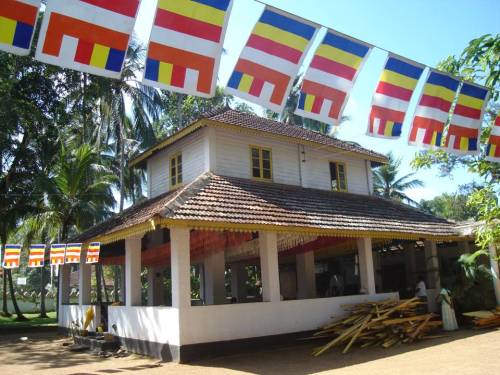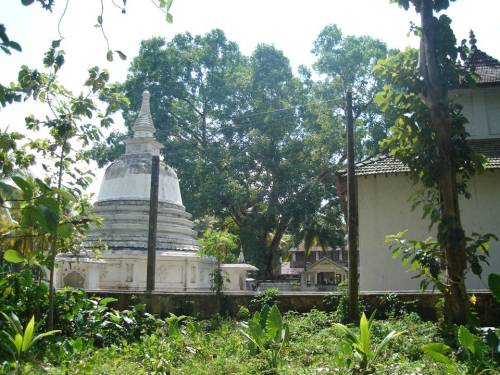Continuing the saga of Raigampura heritage, in this post I like to focus on arguably the greatest ruler of Raigampura kingdom – Prabhuraja Alakeshvara (Alagakkonar).
Image: Veedagama Rajamaha Viharaya was once the centre of Raigampura kingdom
Ibn Batutta, the Arab explorer who supposedly visited Lanka in 1344 AD provides some important information about Raigampura kingdom and Alakeshvaras (Alagakkonars). These were his words:
Then we came to Konakar, the capital of Sultan’s kingdom. It was built on a valley between two mountains, and famous for gems…The Sultan of Konakar is called ‘Al-Konar’. He has a white elephant. I have never seen such a white elephant in any other place I visited. Sultan rides on this elephant decorated with emeralds, on festive occasions. The aristocrats of the land rebelled against the Sultan, made him blind and offered the kingdom to his son.
Unfortunately, nothing in Sri Lankan history tells anything about this ruler son who made his father blind. Perhaps it was because the former ruled only for a short period. Another possibility was the decline of Raigampura as a power centre during this period. Contemporary literatures of the times prove this point.
In ‘Tisara Sandeshya’ written circa 1350 AD, the fictitious messenger (Tisara=swan) travels from Dedigama presumably then in Gampola kingdom to the temple of Upulvan in Devinuvara, but without crossing Raigama. This indicates not only that Devinuvara and surrounding areas in down south (including Mathota or present Matara) was then under the influence of Gampola kingdom, but certainly not Raigama. We do not find even a single source that mentions about Raigampura kingdom or Alakeshvaras during the period 1344-60 AD. As Prof. Paranavithana correctly points out this can be a period Alakeshvaras’ power was confined to a relatively smaller area near western coast.
Image: The land of present Pathahawatte Pushkararama Rajamaha Viharaya is believed to be where Prabhuraja Alakeshvara had his palace. According to Mayura Sandeshaya, the messenger (Mayura=peacock) spent the night at this place so that he could engage in the morning religious rituals at nearby Veedagama Viharaya the next day.
The next ruler in the linage was ‘Prabhuraja Alakeshvara’, but there is an interesting episode before coming to him.
As mentioned earlier too, there were at least three power centres in the isle of Lanka. This is how Rajavaliya puts it:
Alakeshvara manthri lived (=ruled from) Raigama. King Parakramababu’s nephew lived (=ruled from ) Gampola. Out of all rulers king Arya Chakravarti (the king of Jaffna supposedly ruled from Nallur) was more powerful not just in military-wise but also economically. He collected income tax from upcountry, the marine lands and the new port…
The command of Arya Chakravartis was reconfirmed by Ibn Batutta, who describes their supreme naval power. Arya Chakravarti provided guides for Ibn Batutta in his journey to Sri Pada. Batutta says he has seen nearly hundreds of ships at the port he descended to Lanka. (believed to be between Mannar and Puttalum – inclusive of both points) This might be an exaggeration but, it indicates the sort of power Arya Chakravartis yielded.
Death of Buvanekabahu IV of Gampola (1344-51 AD) has created another power battle. According to the rule of the land then the heir to the thrown was the eldest nephew (son of a sister) of the king and not his son or brother. So the rightful owner of throne was Vickramabahu III, the nephew. However before Vickramabahu was crowned in Gampola, king’s younger brother Parakramabahu V has become the rule of Dedigama on his own. It looks like this uncle-nephew power battle has created an interesting episode in Sri Lankan history.
A Tamil inscription found at Kotagama, near Dedigama reveals an attack by Arya Chakravartis on Southern kingdoms around this time, most probably encouraged and assisted by Vickramabahu III from Gampola, who did not tolerate the rise of Dedigama as another power centre. The result of this fight was the fall of short lived Dedigama kingdom and the ruler king Parakramabahu’s flee to Ruhuna. This fact is further supported, says Prof. Paranavithane, by two inscriptions at Magul Maha Viharaya in Panam pattuva. Further, another inscription at Medavala Viharaya mentions after this attack Arya Chakravartis started collecting tax from the Southern areas.
Image: Uyanwatte tank at Kothalawela, Bandaragama the largest man-made reservoir in the western Province, was belived to be first built by Alakeshvaras.
Now enters Prabhuraja Alakeshvara, the powerful ruler of Raigamura kingdom. It was Prabhuraja who finally chased off Arya Chakravarti’s officials from both Raigama and Gampola kingdoms and put a full stop to them collecting tax. This might have happened somewhere between 1360-69 AD. This is the first time he clased with powerful Arya Chakravartis who were backed by the Vijayanagar empire across the sea.
Interestingly, by this time Alakeshvaras have gained adequate power within Gampola kingdom too. (the boundaries of Raigama and Gampola kingdoms continuously varied depending upon the time) This was largely because three Alakeshvara brothers, Artanayake Epa, Prabhuraja Alakeshvara and Deva Manthri has jointly married the sister of Vikramabahu III of Gampola. Her name was princess Jayasiri.
In next post in the series let us look at how Prabhuraja Alakeshvara, arguably the greatest warriors after Vijayabahu I, fought with and chased off the armies of Arya Chakravarti from the Southern parts of the island and how, in the process, he built a fortress in Sri Jayawardenepura – Kotte, parts of which can still be seen.


